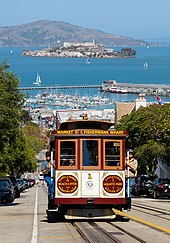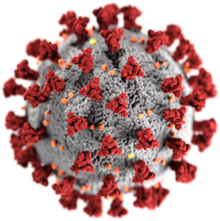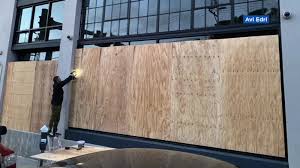San Francisco has long been one of the most-loved cities in the United States.
Millions of tourists—from both other parts of the United States as well as around the world—visit this city every year to ride its famous cable cars and dine in its magnificent restaurants.
To visit the ruins of its infamous prison, Alcatraz, eat Ghiradelli ice cream in Ghiradelli Square and buy souveniers at nearby Fisherman’s Wharf.

San Francisco Cable car
Thomas Wolf, http://www.foto-tw.de / CC BY-SA (https://creativecommons.org/licenses/by-sa/3.0)
But San Francisco today is not the city it has long been renowned for.
Its major tourist spots are deserted. Its sidewalks are largely free of pedestrians. Many of its best-known stores have been shuttered since mid-March—and many of them may never reopen owing to the financial losses they have incurred.
Its world-famous restaurants no longer offer in-house dining—only take-out or home delivery.
Many of its bus routes have been eliminated. With so many people “sheltering-in-place” in their apartments or houses, the passengers that once carried those routes have largely disappeared.
On March 16, the San Francisco Department of Public Health imposed a shelter-in-place order on city residents. This required them to stay home except for essential needs such as shopping for groceries, getting medications, caring for others and exercising.
The goal of the order: To halt—or at least diminish—the spread of COVID-19.

Coronavirus
The order banned activities considered non-essential: Going to bars, barbers and dinner parties.
Many restaurants offer their fare via Grubhub, Doordash, Caviar or Uber Eats. Some restaurants—notably pizza parlors—use their own employees to deliver food.
This, in turn, demands that potential customers have not only a computer but Internet access. It also demands that they be willing to pay a higher price for food than would be the case if they could dine in.
Another drawback: Choosing what items to order from many restaurants is like choosing what to order in the military: You either accept what they offer—or you do without. Forget about substitutions or additions.
Outdoor exercise is allowed, but gyms are closed.
Some businesses were deemed essential. Among these: Grocery stores, hardware stores, hospitals, drugstores, laundromats, funeral parlors, gas stations, airlines, taxis, rental car companies, childcare facilities, rideshare services.
The effect of the shutdown order on businesses has been devastating.
Walk along Market Street—the city’s best-known site for marches and storefronts—and you’ll find store after store not only closed but boarded up. The same for Powell Street, a major tourist magnet.

The city’s internationally famous cable car lines have all been shut down. With “social distancing” the new Golden Rule, cramming people onto small cable cars is no longer an option.
Taxis are still available—but cab drivers have found business difficult to come by, with so many people staying indoors.
The order allowed most marijuana dispensaries to remain open. Bookstores, on the other hand, were ordered closed—and remain so more than two months later.
So businesses selling toxic “medical marijuana” are considered essential. But if you want to buy a copy of Moby Dick at your local bookstore, you’ll have to do it online.
Many businesses started boarding up in April. The reason: Fears that Coronavirus-inspired shortages of items like toilet paper, meat and hand sanitizer might lead to wholesale looting.
Then, on May 25, as if facing a deadly pandemic wasn’t enough of a threat, a new and unexpected reason for fear emerged: The killing of George Floyd, a former black security guard, in Minneapolis, Minnesota.
While Floyd was handcuffed and lying face down on a city street during an arrest, Derek Chauvin, a white Minneapolis police officer, kept his knee on the right side of Floyd’s neck for eight minutes and 46 seconds.

The death of George Floyd
Across the nation, cities were convulsed by protests—including those in the San Francisco Bay Area. Among these: Oakland, San Jose, Emeryville, Walnut Creek and San Francisco itself.
On May 30, an initially peaceful protest march exploded into looting shortly before 9 p.m. as looters broke off and began smashing shop windows and ransacking stores in Union Square and on Market Street.
Among stores looted: A Sak’s Off Fifth Avenue, Old Navy clothing store, a Cartier Boutique, a Coach store. Looters especially targeted CVS and Walgreens drugstores. Liquor stores and a BevMo were also hit.
“Thirty businesses were looted or destroyed,” said David Perry, from Union Square Business Improvement District. A total of 33 arrests were made for “criminal activity.”
That night, San Francisco Mayor London Breed announced that she would impose a citywide curfew beginning May 31, running from 8:00 p.m to 5 a.m.
On the night of May 31, 87 people were arrested for violating the city’s curfew.
Left unstated by city authorities—within San Francisco and across the nation—was this: With so many people massing in streets, many of them unmasked, would this spread COVID-19 even further?
Northern California—and San Francisco in particular—have closely cooperated with “stay-at-home” orders. As a result, COVID-19 cases have remained relatively stable in those areas.
But the street demonstrations may well reverse the results of those months of self-discipline. The truth will be known only weeks from now.
ABC NEWS, ALCATRAZ PRISON, ALTERNET, AMERICABLOG, AP, BABY BOOMER RESISTANCE, BAY AREA RAPID TRANSIT (BART), BLOOMBERG, BOOKSTORES, BUSINESS CLOSURES, BUZZFEED, CABLE CARS, CAVIAR, CBS NEWS, CNN, CORONAVIRUS, COVID-19, CROOKS AND LIARS, DAILY KOZ, DDMBS (DRUGGIES, DEREK CHAUVIN, DONALD TRUMP, DOORDASH, DRUDGE RETORT, DRUNKS, EMERYVILLE, FACEBOOK, FISHERMAN’S WHARF, FIVETHIRTYEIGHT, GEORGE FLOYD, GHIRADELLI SQUARE, GRUBHUB, HARPER’S MAGAZINE, LONDON BREED, LOOTING, MARKET STREET, MASKS, MEDIA MATTERS, MEDICAL MARIJUANA, MENTALS AND BUMS), MOTHER JONES, MOVEON, MSNBC, NBC NEWS, NEWSWEEK, NPR, OAKLAND, PBS NEWSHOUR, POLITICO, POLITICUSUSA, POWELL STREET, RAW STORY, RESTAURANTS, REUTERS, SALON, SAN FRANCISCO, SAN FRANCISCO DEPARTMENT OF PUBLIC HEALTH, SAN FRANCISCO MUNICIPAL RAILWAY (MUNI) SYSTEM, SAN JOSE, SEATTLE TIMES, SLATE, SOCIAL DISTANCING, TALKING POINTS MEMO, THE ATLANTIC, THE CHICAGO SUN-TIMES, THE CHICAGO TRIBUNE, THE DAILY BEAST, THE DAILY BLOG, THE GUARDIAN, THE HILL, THE HUFFINGTON POST, THE LOS ANGELES TIMES, THE NATION, THE NEW REPUBLIC, THE NEW YORK TIMES, THE VILLAGE VOICE, THE WASHINGTON POST, THINKPROGRESS, TIME, TRUTHDIG, TRUTHOUT, TWITTER, TWO POLITICAL JUNKIES, U.S. NEWS & WORLD REPORT, UBER EATS, UPI, USA TODAY, VANDALISM, WALNUT CREEK, WONKETTE
THE CHANGED FACE OF SAN FRANCISCO: PART TWO (END)
In Bureaucracy, History, Law, Law Enforcement, Politics, Social commentary on June 3, 2020 at 12:25 amSan Francisco has long been one of the most-loved cities in the United States.
Millions of tourists—from both other parts of the United States as well as around the world—visit this city every year to ride its famous cable cars and dine in its magnificent restaurants.
To visit the ruins of its infamous prison, Alcatraz, eat Ghiradelli ice cream in Ghiradelli Square and buy souveniers at nearby Fisherman’s Wharf.
San Francisco Cable car
Thomas Wolf, http://www.foto-tw.de / CC BY-SA (https://creativecommons.org/licenses/by-sa/3.0)
But San Francisco today is not the city it has long been renowned for.
Its major tourist spots are deserted. Its sidewalks are largely free of pedestrians. Many of its best-known stores have been shuttered since mid-March—and many of them may never reopen owing to the financial losses they have incurred.
Its world-famous restaurants no longer offer in-house dining—only take-out or home delivery.
Many of its bus routes have been eliminated. With so many people “sheltering-in-place” in their apartments or houses, the passengers that once carried those routes have largely disappeared.
On March 16, the San Francisco Department of Public Health imposed a shelter-in-place order on city residents. This required them to stay home except for essential needs such as shopping for groceries, getting medications, caring for others and exercising.
The goal of the order: To halt—or at least diminish—the spread of COVID-19.
Coronavirus
The order banned activities considered non-essential: Going to bars, barbers and dinner parties.
Many restaurants offer their fare via Grubhub, Doordash, Caviar or Uber Eats. Some restaurants—notably pizza parlors—use their own employees to deliver food.
This, in turn, demands that potential customers have not only a computer but Internet access. It also demands that they be willing to pay a higher price for food than would be the case if they could dine in.
Another drawback: Choosing what items to order from many restaurants is like choosing what to order in the military: You either accept what they offer—or you do without. Forget about substitutions or additions.
Outdoor exercise is allowed, but gyms are closed.
Some businesses were deemed essential. Among these: Grocery stores, hardware stores, hospitals, drugstores, laundromats, funeral parlors, gas stations, airlines, taxis, rental car companies, childcare facilities, rideshare services.
The effect of the shutdown order on businesses has been devastating.
Walk along Market Street—the city’s best-known site for marches and storefronts—and you’ll find store after store not only closed but boarded up. The same for Powell Street, a major tourist magnet.
The city’s internationally famous cable car lines have all been shut down. With “social distancing” the new Golden Rule, cramming people onto small cable cars is no longer an option.
Taxis are still available—but cab drivers have found business difficult to come by, with so many people staying indoors.
The order allowed most marijuana dispensaries to remain open. Bookstores, on the other hand, were ordered closed—and remain so more than two months later.
So businesses selling toxic “medical marijuana” are considered essential. But if you want to buy a copy of Moby Dick at your local bookstore, you’ll have to do it online.
Many businesses started boarding up in April. The reason: Fears that Coronavirus-inspired shortages of items like toilet paper, meat and hand sanitizer might lead to wholesale looting.
Then, on May 25, as if facing a deadly pandemic wasn’t enough of a threat, a new and unexpected reason for fear emerged: The killing of George Floyd, a former black security guard, in Minneapolis, Minnesota.
While Floyd was handcuffed and lying face down on a city street during an arrest, Derek Chauvin, a white Minneapolis police officer, kept his knee on the right side of Floyd’s neck for eight minutes and 46 seconds.
The death of George Floyd
Across the nation, cities were convulsed by protests—including those in the San Francisco Bay Area. Among these: Oakland, San Jose, Emeryville, Walnut Creek and San Francisco itself.
On May 30, an initially peaceful protest march exploded into looting shortly before 9 p.m. as looters broke off and began smashing shop windows and ransacking stores in Union Square and on Market Street.
Among stores looted: A Sak’s Off Fifth Avenue, Old Navy clothing store, a Cartier Boutique, a Coach store. Looters especially targeted CVS and Walgreens drugstores. Liquor stores and a BevMo were also hit.
“Thirty businesses were looted or destroyed,” said David Perry, from Union Square Business Improvement District. A total of 33 arrests were made for “criminal activity.”
That night, San Francisco Mayor London Breed announced that she would impose a citywide curfew beginning May 31, running from 8:00 p.m to 5 a.m.
On the night of May 31, 87 people were arrested for violating the city’s curfew.
Left unstated by city authorities—within San Francisco and across the nation—was this: With so many people massing in streets, many of them unmasked, would this spread COVID-19 even further?
Northern California—and San Francisco in particular—have closely cooperated with “stay-at-home” orders. As a result, COVID-19 cases have remained relatively stable in those areas.
But the street demonstrations may well reverse the results of those months of self-discipline. The truth will be known only weeks from now.
Share this:
Related